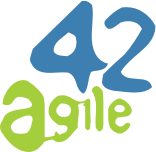
All Agile
The Agile Change
You can't buy Agile. Becoming a resilient organisation and adapting to an Agile way of working requires a shift in mindset and culture. People need to communicate differently; collaboration between teams will change; and managers will have to become Agile leaders. Our focus is on the business success of our customers. Our coaches have seen and supported many companies in becoming Agile and can quickly recognize gaps in the system, communication failures, and technologies that might be posing problems.
ORGANIC Agility & ETF
Culture and business goals/processes are like an organization’s DNA. When both are aligned, they enable organizations to become resilient and able to handle future market challenges. In order to support your organization in finding its best “DNA", agile42 provides ORGANIC Agility and the Enterprise Transition Framework (ETF).
Agile unique to you

Teams and organizations have their own unique reasons for wanting to become Agile. Reasons such as higher efficiency, better team performance, faster delivery, and many others are often stated. Whatever your reason, Agile will bring you better collaboration, communication, and transparency. However, let it be said: There is no blueprint to becoming Agile. As your team or organization is unique, so too will be your Agile implementation.
Are you ready for the Agile change?

Agile has much to do with focus, adaptability, discipline, structure and... yes, also the readiness and willingness to challenge the status quo. The unique environment, culture, relationship, maturity and market situation of your organization determines the focus and effort needed to make an Agile transition successful.
Most importantly, do not underestimate the complexity and impact of the change you are considering.
ORGANIC Agile
For a long time, organizations were seen more as machines in which processes are repeatable and, once set in motion, remain always the same. At agile42 we instead compare a company to an organism which grows, changes, and becomes resilient against external influences.
An organisation’s Agile transformation changes the organizational culture itself. This requires embracing a different set of values and principles, and so establishing a mindset strongly focused on collaboration and delivering customer value.
ORGANIC Agility recognises all organisational dimensions and contexts in order to create alignment between culture and business. The goal is to reduce process overhead as much as possible and create an environment of continuous improvement.
Enterprise Transition Framework (ETF)

The Enterprise Transition Framework (ETF) enables an organization to implement the Agile principles and values globally, beyond the team level. It allows organizations of all sizes to evolve incrementally and improve just as agile teams do; through a continuous learning process with fast feedback cycles and regular retrospectives.
By focusing on evaluating the changes you wish to implement – normally through experimentation with a set of pilot projects, which will demonstrate what makes sense to adopt permanently - you will be able to transition with limited risk and guaranteed long-term success.

Agile within a Team
At a team level Agile manifests itself by allowing a group of people to grow together through collaboration – by committing as a whole to a common and shared goal. Agile creates new responsibilities, clarifies expectations and provides a working environment which is based on trust and transparency. The framework Scrum is often used to support the Agile way of working, as well as Kanban and XP, among others.


